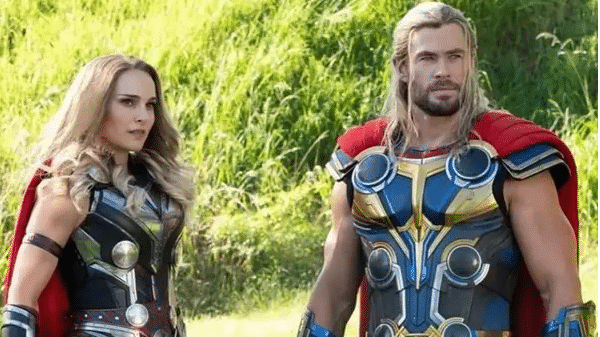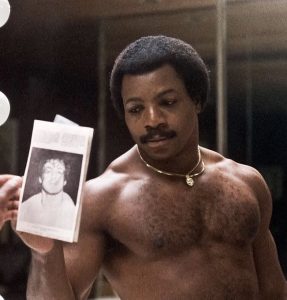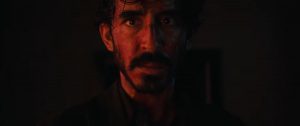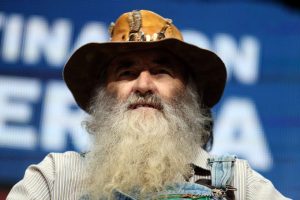Taika Waititi, known for movies like ‘Jojo Rabbit’ and ‘Hunt for the Wilderpeople’, made ‘Thor: Ragnarok‘ the biggest film of the franchise, but might have outdone himself with the follow-up ‘Thor: Love and Thunder‘.
[Spoilers ahead]
A charming and irreverently funny director turned the course of the Thor movies from their usual fanfare of gloom and doom, to a riot of colours, jokes, and emotions much better suited to the Marvel Cinematic Universe (MCU) content slate.
It almost seems like stars aligning, when one thinks back to ‘The Story of Marvel Studios’, which detailed how Waititi almost missed his chance to pitch the idea to MCU boss Kevin Feige. Even after the project was greenlit, the director had to contend with fans, who weren’t sure he was up to the task. Waititi, however, had no intention to continue the franchise down the same path. Much like Thor, he wished to take a hammer to it and smash it all down.
That’s exactly why ‘Ragnarok’ became a refreshing change, and ‘Love and Thunder’ carries that legacy forward, with the director admitting in an interview with The Playlist that there hasn’t been much difference in filming his second Thor project. “I don’t think there’s been any difference. I mean really, it’s a similar size and everything’s the same. There’s a few different actors, but the energy and the intention is all still the same”, the 46-year-old said.
Korg, voiced by Waititi, was introduced in ‘Ragnarok’ and became an immediate comic success – with fans and actor Chris Hemsworth, who wanted more scenes with the Kronan warrior. The director delivers just that, using him to catch the audience up to speed with what’s going on in Thor’s life. The events pick up after ‘Avengers: Endgame’, where we saw the God of Thunder settle into a Big Lebowski look. The opening moments trace Thor’s journey so far, and how he got back into shape, placing the Asgardian with the Guardians of the Galaxy for the time being.
Due to the expansive nature of the MCU, now that we’re in Phase 4, films often have to employ narrative techniques to give brief recaps, to maintain plot integrity without viewers having to recollect and connect the dots. ‘Ant-Man‘ has one of the best options available in Michael Pena’s Luis, Scott Lang’s fast-talking and funny associate. However, it might have met its match in Korg’s storytelling method. Waititi also uses theatre interestingly, and as a tool for education. Plays were earlier a means for people to know about their gods and their adventures. In ‘Love and Thunder’, the story of ‘Ragnarok’ is briefly played out on stage by the same actors who entertained Loki in the last film. However, this time they’re not performing for Thor’s mischievous brother, but rather for tourists and other Asgardians.
A play within a Marvel movie wouldn’t get much attention, but Waititi’s handling makes it incisive, even showing how special effects work on stage – when Thor’s hammer moves towards Hela, who catches and destroys it. Speaking of – Luke Hemsworth, Chris’ brother plays Thor in the play, while Melissa McCarthy adds a dash of a comic touch to on-stage Hela, played by Cate Blanchett in ‘Ragnarok’. Mark Wahlberg also returns as on-stage Loki, playing Tom Hiddleston’s character with a fun flair.
Also Read | Thor Love and Thunder: Korg misnames Jane Foster as Jodie Foster, Jane Fonda
With the audience up to speed on what’s going on in Thor’s life, we see the Asgardian trying to be zen. He meditates unless someone needs his help in battle. This happens almost evidently, when Peter Quinn or Star-Lord, asks him for help – something that also seems like a frequent occurrence.
This mission ultimately sets Thor on Gorr the God Butcher’s trail. He realizes that gods are being slain, and the film shows us in the opening moments that Gorr, a man who lost his child to an indifferent god, has gotten hold of the Necrosword and is on a path of vengeance.
Marvel films have faced their fair share of criticism from cinematic greats like Martin Scorsese and Francis Ford Coppola, with the former comparing them to “theme parks” in a now hotly-debated comment. However, the observations aren’t without bases – and rightly so considering Scorsese is not just a director but a film historian with a near-encyclopaedic knowledge of cinema.
So, if you walk in expecting twists and turns in the film structure or narration, then you’re likely to walk away disappointed. It starts by establishing the villain – Gorr, and shows how dangerous his weapon, the Necrosword is. Once viewers are convinced that it’ll pose a threat to Thor, the film proceeds to show the Asgardian’s current fighting form, setting up the big clash everyone knows will come toward the end of the movie.
Waititi’s genius lies in what he does within this broad structure. While viewers anticipate the final battle, there are various other plot points that demand attention – the most pressing being Jane Foster’s cancer. The scientist ultimately banks on Mjolnir, Thor’s hammer, to keep the cancer at bay, and thus Mighty Thor is born.
Also Read | Thor Love and Thunder: ‘Interstellar’, ‘Event Horizon’ references explained
The director merges comic book lines with his creative license by including gods like Ninny of the Nonny and Bao, the god of dumplings. We see them when Thor goes to Omnipotence City – something established in Marvel comics, to ask Zeus for help against Gorr.
Upon being turned down, the Asgardian pulls off a daredevil feat, taking on the God of Lightning and getting the better of him. Foster, Valkyrie, Korg, and Thor escape with Zeus’ lightning bolt, on the chariot drawn by Thor’s iconic goats, who find an entry in this movie.
When the idea of the goats was initially pitched, MCU didn’t go for it, but with the atmosphere Waititi creates, the giant bleating creatures fit right in. After the escape, they’re equipped to take on Gorr and journey to the Shadow Realm.
All this while, Thor has been dealing with the search for who he wants to be. He’s already given the helm of King of Asgard to Valkyrie, who runs the Norway tourist spot cum abode of Gods in an enterprising manner – with board meetings and product advertisements, the picture of a modern-day working woman. Before parting ways with the GOTG, to whom Thor’s grown quite attached, Quinn tells him that feeling bad about a loss is better than not feeling anything at all. This refocuses attention to Thor’s love life, of course, and we learn that his breakup with Foster didn’t go too well – they ended things over a note.
After over eight years apart, the two are now working together to save the world – talk about awkward workplace experiences with exes. Thor embodies all the flustering of a lover who’s hung up over the breakup, but the journey to face Gorr gives Foster and him some time to catch up. They both realize how they didn’t make time for each other, and Thor shows signs of maturity, at which point they reconcile. Waititi makes this entire scene enchanting and almost dream-like, with the Bifrost creating aurora-like skies, and the travellers catching sight of space dolphins.
Also Read | Thor Love and Thunder: Who is Gorr’s daughter and what are her powers?
The battle with Gorr is no joking matter, and soon the colours fade as viewers become aware it is time for business. Even in the showdowns, Waititi retains a sense of humour, when Gorr asks him to summon the war-axe Stormbreaker, so he can use it to open the Bifrost, go to Eternity and make a wish for all gods to be dead. Thor replies he’ll do it if Gorr calls a dentist, referring to Christian Bale’s character’s appearance – where his poor dental state has already become a talking point among viewers.
In the first bout – keeping to the structure of any true superhero movie – Thor suffers a defeat and loses Stormbreaker. Gorr seems to be a step closer to achieving his goal and the Asgardian is nowhere close to retrieving the kids of their Norway town who Gorr kidnapped to lure Thor. Armed with Zeus’ bolt and in true heroic fashion, Thor goes off to fight Gorr again, and this time, he enlists the help of the children, among whom is Heimdall’s son.
Disney, for all its political correctness, might be raising some eyebrows at the idea of Thor commandeering a child army, or maybe that is the characteristic Waititi irreverence in play, but the scene makes for enjoyable cinema. The children arm themselves with weapons, and one picks a stuffed bunny. However, when Thor bestows them with his power, they are enough to take down Gorr’s shadow creatures.
Thor’s personal battle doesn’t go as well, and he takes a beating, but again, this allows for the other ethical conundrum to arise in the movie – whether Foster should risk her life to save Thor.
She’s faced with the truth that Mjolnir is draining her life, not allowing her body to fight cancer. Before the final battle, Thor professes his love and offers a life together, but Foster prefers to go out in a blaze of glory, helping the man she loves and fighting by his side. They might not have made it work, but come to think of it, Thor and Jane Foster share some remarkable similarities.
Also Read | ‘Thor: Love and Thunder’ mid and end credits explained
With Mighty Thor entering the fight, the two destroy Gorr’s sword but he still manages to reach Eternity. Jane is spent and on her last legs, while Gorr is close to getting what he wants. Thor has only one option – reason. In a true sign of evolving from the man who courted war, Thor advises Gorr to choose love, to bring back the child he lost, instead of continuing with revenge. During his monologue, perhaps he too realizes that all anyone is looking for is love. Or maybe, Thor realizes that before and wants to spend Jane’s final moments with her, rather than fighting the God Butcher.
Gorr agrees and makes Thor promise to look after his child, who now possesses powers since Eternity brought her back. Thor’s purpose is clear – raising this child in the way of a warrior, so she too can protect and defend the realms. This is exactly what he sets about doing, while those back on New Asgard – the Nordic town on Earth, start preparing to train the children better, so they’re not exposed to attacks like these. The film ends, suggesting, that the future of Asgard is in better hands.
Though the story ends as expected, Waititi touches upon several important strands – from Thor’s self-discovery, which led the director to once label this a “midlife crisis” movie, to the indifference celestial beings, if existent, likely feel toward us.
The film also expertly navigates human relationships and the bond between people and their weapons – as evidenced by Foster’s attachment to Mjolnir, and Thor placating Stormbreaker while pining after his old hammer. It leads to some hilarious and touching moments in ‘Love and Thunder’.
By introducing new characters like Heimdall’s son, the plot also opens avenues for future Thor movies to explore. With a generous helping of Guns N’ Roses songs, from ‘Paradise City’ to ‘Welcome to the Jungle’ and ‘Sweet Child O’ Mine’, there’s never really a dull moment in the film, which is what Waititi and MCU have always set out to do – talk about theme parks!
Inspired by an 80s aesthetic, the director said in a Rolling Stone interview he wanted the whole movie to feel like an “electric-guitar lead break”.
Also Read | James Caan quotes: ‘The Godfather’ Sonny Corleone’s most popular sayings
He succeeds on all counts, except one. Gorr is shown as a wholly evil character who must be stopped, without much attention paid to the revenge motif that drives him. The handling could be a bit more nuanced with the parts between Gorr and Mighty Thor fleshed out – even where Natalie Portman’s character rightly asserts her identity as being different from ‘Lady Thor’, which is how the comics portray her. Gorr and Foster have a unique problem where the very power they wield, is killing them. The psychological conundrum would be a delicious avenue to explore, especially with an actor of Bale’s calibre playing the part.
The climax where Thor convinces Gorr to make the right decision is the second time the revenge motif becomes evident, after the very initial death of Gorr’s child. To have humanized the villain, especially one dealing with personal loss, would have held a better mirror for a hero who’s himself coping with such loss.
This slightly skewered portrayal of Gorr aside, ‘Thor: Love and Thunder’ will leave viewers thoroughly entertained, and with almost no regrets – except perhaps not finding out what Foster’s superhero catchphrase would be, had she not succumbed to cancer.







